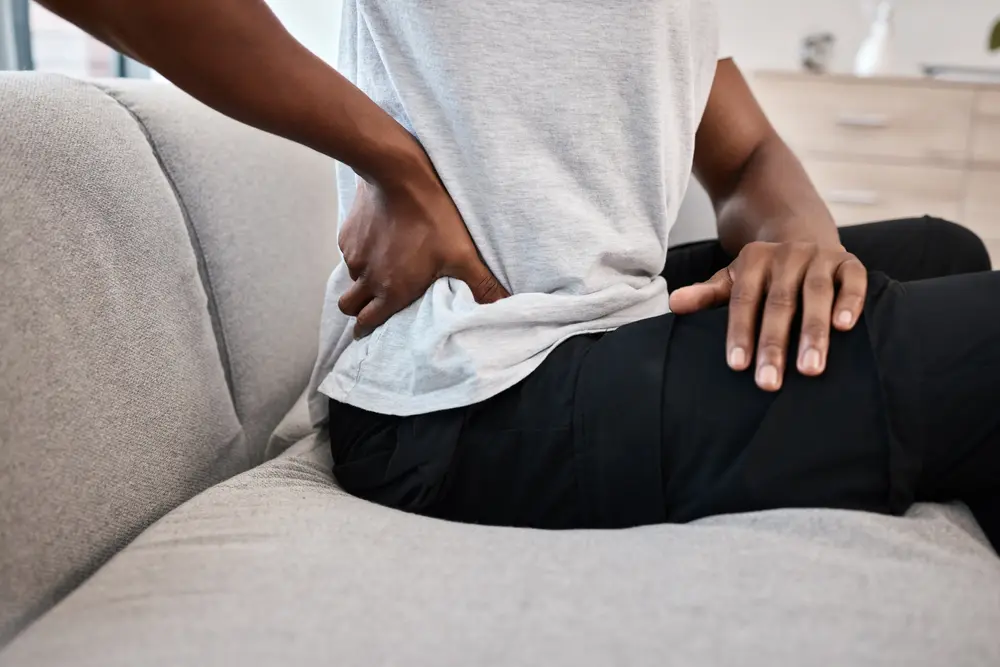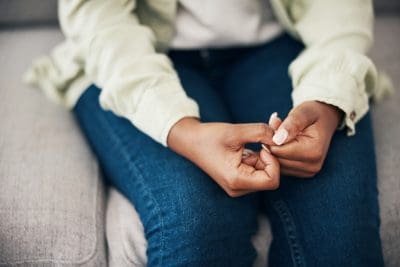That nagging shoulder ache that always appears on your right side. The knee that gives you trouble only on the left. The hip pain that never seems to affect both sides equally. If you’ve noticed that your body seems to play favorites with pain, you’re not imagining things.
Most people experience asymmetrical pain patterns throughout their lives, with one side consistently bearing the brunt of discomfort. This seemingly odd quirk of human physiology isn’t random chance but reflects fascinating aspects of how our bodies are built and how we use them.
Let’s explore the surprising reasons behind this common but rarely discussed phenomenon.
Your dominant side bears the burden
The most obvious explanation for one-sided pain starts with handedness. Whether you’re right or left-handed influences virtually every movement you make, creating significant imbalances over time.
Your dominant side typically performs more precise, controlled movements while your non-dominant side often handles stabilization duties. Think about how you throw a ball, chop vegetables, or brush your teeth. One side does the intricate work while the other provides support.
This division of labor creates distinctive wear patterns. Your dominant shoulder, elbow, and wrist absorb more repetitive strain from activities requiring precision. Meanwhile, your non-dominant side develops different muscle patterns from its supporting role.
The pain consequences play out in predictable ways. Tennis elbow, rotator cuff injuries, and carpal tunnel syndrome appear more frequently on the dominant side due to overuse. But interestingly, lower back and hip pain often plague the non-dominant side, which compensates for the dominant side’s movements by providing stability.
This functional asymmetry begins in childhood and deepens throughout life, creating biomechanical patterns that can remain even when you consciously try to use both sides equally.
The twisted truth about your spine
Beyond handedness, your spine harbors natural asymmetries that influence pain patterns. Even in perfectly healthy people, the spine rarely forms a straight line when viewed from behind.
Most adults have slight natural curves in their spine, with research showing that about 80% of people have a right thoracic left lumbar curve pattern. This means the upper spine curves slightly right while the lower spine curves slightly left.
These natural curves create baseline asymmetries in how forces distribute through your body. When you stand, walk, or sit, one side consistently bears different mechanical stresses than the other. Over years, these subtle differences can manifest as one-sided pain patterns.
Your organs contribute to these asymmetries too. Your liver occupies significant space on the right side of your abdomen, while your heart pulls slightly left in your chest. These organ arrangements influence surrounding muscle tensions and fascial connections, creating different structural environments on each side.
The consequences appear in common pain patterns. Right-sided mid-back pain frequently occurs where the natural spinal curve creates increased pressure. Left-sided low back pain often appears where the compensatory curve places additional stress on joints and muscles.
These structural realities mean that even with perfect posture and balanced muscle development, some degree of pain asymmetry would likely still exist.
The footwear factor
Look down at your feet. The shoes on them might be driving your one-sided pain patterns more than you realize.
Most roads, sidewalks, and floors aren’t perfectly level. They slope slightly for drainage or have worn unevenly over time. When you walk on these surfaces, one leg effectively becomes slightly longer than the other for thousands of steps each day.
This subtle leg length difference forces your body to compensate. Your pelvis tilts, your spine curves, and your weight shifts, creating asymmetrical forces that travel upward through your entire body.
Surprisingly, even symmetrical surfaces cause problems because of how we use them. Most people consistently stand with more weight on one leg than the other, creating a habitual stance that reinforces imbalances. Over years, this “easy standing” position trains your body to distribute forces unevenly.
Footwear itself contributes significantly. Shoes wear down asymmetrically based on your gait pattern, with most people showing more wear on the outer edge of their dominant foot and the inner edge of their non-dominant foot. This uneven wear creates a subtle but significant slope that reinforces existing movement asymmetries.
High heels magnify these effects dramatically, typically causing more pain on the side opposite your dominant hand as your body compensates for the shifted center of gravity.
The sleeping position revelation
Your pain asymmetry might develop largely while you’re completely unaware, during the third of your life spent sleeping.
Most people consistently favor one sleeping position, whether it’s right side, left side, or some variation of stomach or back sleeping with a limb preference. This position preference keeps certain joints compressed and others extended for hours every night.
Side sleepers place substantial pressure on the shoulder, hip, and knee of their preferred side. Over years, this pressure can compress joint spaces, affect tissue hydration, and create wear patterns that manifest as pain.
The fetal position, where you curl up on one side with knees drawn toward the chest, creates particular asymmetries. The downside shoulder rotates inward, the downside hip flexes significantly, and the spine curves toward the front of the body. These positions, maintained for hours nightly, train your tissues to adapt asymmetrically.
Pillow placement compounds these effects. The common habit of sleeping with one arm under a pillow places that shoulder in an impingement position. The resulting shoulder and neck pain typically appears on your preferred sleeping side.
Some asymmetries create unexpected patterns. Stomach sleepers who turn their head to one side consistently, typically the right, often develop left-sided low back pain as the spine twists to accommodate the head position.
The stress and emotion connection
Your psychological state influences physical pain in surprisingly asymmetrical ways. The connection between your brain and body doesn’t affect both sides equally.
Stress hormones don’t distribute evenly through your body. Research shows that stress can amplify pain perception more significantly on your non-dominant side due to differences in how your brain processes sensory information from each side of your body.
Your emotional patterns play a role too. Many people unconsciously clench muscles on one side during stress or anxiety. This one-sided tension habit, often concentrated in the jaw, neck, and shoulder, creates pain patterns that consistently favor the same side during emotional distress.
Cultural body language affects these patterns as well. Right-handed people tend to process negative emotions more on their left side, sometimes leading to increased left-sided pain during periods of emotional difficulty.
The brain-pain connection extends to how you perceive discomfort. Research suggests that pain on your dominant side often registers as more mechanically focused and easier to localize precisely. In contrast, non-dominant side pain frequently feels more diffuse and emotionally disturbing.
The surprising solution approach
Understanding why your pain follows asymmetrical patterns offers insights into more effective relief strategies.
Cross-training becomes crucial for long-term pain management. This means deliberately training your non-dominant side with tasks usually reserved for your dominant side. Simple practices like brushing teeth, stirring cooking pots, or carrying bags with your non-preferred hand help rebalance muscle development patterns.
Sleeping position modifications can dramatically reduce one-sided pain. If you consistently wake with pain on one side, experiment with pillow arrangements that discourage your habitual sleeping position. Body pillows can prevent rolling to your preferred side, while strategically placed smaller pillows can support joints that typically bear compression.
Footwear rotation breaks harmful patterns. Rather than wearing the same shoes daily, rotating between multiple pairs prevents reinforcing the same wear patterns. For persistent asymmetrical pain, professional assessment for subtle leg length differences might suggest heel lifts or custom orthotics.
Mindfulness practice helps identify unconscious tension patterns. Many people discover they habitually tense one shoulder or clench muscles on one side during stress. Simply becoming aware of these patterns allows you to release this uneven tension before it creates pain.
Targeted strengthening of the consistently painful side rarely solves the problem alone. More effective approaches strengthen the opposite side appropriately while improving overall movement patterns. This balanced approach addresses the underlying asymmetrical forces rather than just treating symptoms.
The fact that pain favors one side of your body isn’t a random annoyance but a window into how your unique structure, habits, and history interact. By understanding these patterns, you gain powerful insights into breaking the cycle of recurring one-sided pain that has frustrated you for years.











